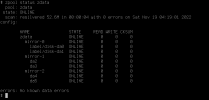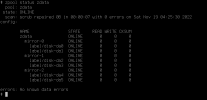Currently I have setup the OS on the last disks da6 and da7 but it appears that on the HPE dl380 gen9 these disk order may change since these disks are 2 disks on the rear. If I add 2 new disks to the front, the disk order will change (the last 2 disks will become da8/da9). Is there a way to change the pool to access to the disks by IDs instead?
Code:
$ zpool status
pool: zdata
state: ONLINE
config:
NAME STATE READ WRITE CKSUM
zdata ONLINE 0 0 0
mirror-0 ONLINE 0 0 0
da0 ONLINE 0 0 0
da1 ONLINE 0 0 0
mirror-1 ONLINE 0 0 0
da2 ONLINE 0 0 0
da3 ONLINE 0 0 0
mirror-2 ONLINE 0 0 0
da4 ONLINE 0 0 0
da5 ONLINE 0 0 0
errors: No known data errors
pool: zroot
state: ONLINE
config:
NAME STATE READ WRITE CKSUM
zroot ONLINE 0 0 0
mirror-0 ONLINE 0 0 0
da6p4 ONLINE 0 0 0
da7p4 ONLINE 0 0 0
errors: No known data errors
Last edited by a moderator:




